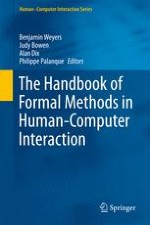This book provides a comprehensive collection of methods and approaches for using formal methods within Human-Computer Interaction (HCI) research, the use of which is a prerequisite for usability and user-experience (UX) when engineering interactive systems.
World-leading researchers present methods, tools and techniques to design and develop reliable interactive systems, offering an extensive discussion of the current state-of-the-art with case studies which highlight relevant scenarios and topics in HCI as well as presenting current trends and gaps in research and future opportunities and developments within this emerging field.
The Handbook of Formal Methods in Human-Computer Interaction is intended for HCI researchers and engineers of interactive systems interested in facilitating formal methods into their research or practical work.
